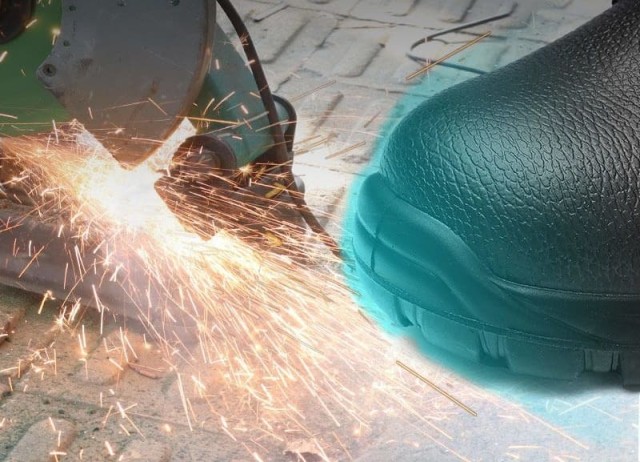Workplace safety is non-negotiable, especially in industries where cutting hazards are a daily threat. Safety boots are engineered with advanced materials and rigorous testing protocols to mitigate these risks. This article breaks down the technical mechanisms behind cut-resistant footwear, the industry standards that validate their effectiveness, and real-world applications that prove their life-saving potential.
Anatomy of Cutting-Resistant Safety Boots
Cutting hazards demand more than just a sturdy exterior—they require a multi-layered defense system. Modern safety boots integrate three critical components:
-
Reinforced Toe Caps:
- Traditionally made of steel, now increasingly replaced by lightweight composites like fibreglass or Kevlar.
- Designed to withstand impact and compression while reducing fatigue.
-
Cut-Resistant Uppers:
- High-performance materials like ballistic nylon or laminated leather resist abrasion and slicing.
- Some designs incorporate chainmail-like mesh for extreme environments (e.g., forestry or metal fabrication).
-
Puncture-Proof Midsoles:
- Thin but dense layers of metal or composite materials stop sharp objects from penetrating the sole.
Why it matters: A single lapse in foot protection can lead to severe injuries. For example, in construction, a misplaced blade or falling debris can slice through ordinary footwear—but cut-resistant boots act as a shield.
Material Science: From Steel Toe to Composite Armor
The evolution of safety boot materials reflects a balance between protection and practicality:
Traditional vs. Modern Materials
| Material | Pros | Cons |
|---|---|---|
| Steel | High impact resistance | Heavy, conducts temperature |
| Kevlar® | Lightweight, cut-resistant | Less effective against crushing |
| TPU Outsoles | Oil- and slip-resistant | Less durable than rubber |
Key innovations:
- Composite Toe Caps: Fibreglass-reinforced polymers offer steel-level protection at half the weight.
- Multi-Density Outsoles: Rubber compounds with varying hardness levels improve grip and longevity.
Real-world insight: Workers in oil refineries, for instance, benefit from boots with nitrile rubber soles—resistant to chemicals and heat—while warehouse staff prioritize lightweight TPU for all-day comfort.
Industry Standards and Testing Protocols
Safety boots aren’t effective unless they meet certified benchmarks. Globally recognized standards include:
- ASTM F2412/F2413: Tests for impact resistance (e.g., a 75-lb weight dropped from 1 foot) and compression (2,500 lbs of force).
- ISO 20345: Evaluates toe cap integrity and slip resistance under EU regulations.
- EN ISO 22568: Focuses on chainmail protection for forestry boots.
Did you know? Boots labeled "ASTM F2413-18 I/75 C/75" have passed impact (75 ft-lbs) and compression (2,500 lbs) tests. Such granular ratings help employers match footwear to specific hazards.
Case Studies: Reducing Injuries in High-Risk Sectors
1. Manufacturing Plants
- A 2022 study in automotive factories showed a 40% drop in foot lacerations after switching to boots with Kevlar-lined uppers.
2. Construction Sites
- Steel-toe boots with puncture-resistant midsoles reduced nail-related injuries by over 60% in a U.S. highway project.
3. Agriculture
- Chainmail-reinforced boots prevented 90% of cutting injuries among forestry workers handling chainsaws.
The takeaway: Investing in certified safety boots isn’t just compliance—it’s a measurable ROI in workforce health and productivity.
Step Into Safety with 3515
Whether you’re a distributor sourcing bulk orders or a brand owner seeking custom designs, 3515 delivers safety boots engineered for real-world hazards. Our expertise spans materials, certifications, and sector-specific solutions—ensuring every pair meets the highest standards.
Ready to upgrade your safety footwear? Partner with 3515 to equip your team with boots that blend cutting-edge protection with all-day comfort.
By understanding the science and standards behind cut-resistant safety boots, businesses can make informed choices that protect their most valuable asset: their people. From composite armors to rigorous testing, these technologies quietly redefine workplace safety—one step at a time.
Related Products
- Wholesale Customizable Suede Safety Boots - Puncture-Proof with Velcro Closure
- Durable Mid-Cut Tactical Boots for Wholesale & Private Label
- Wholesale Durable 6-Inch Work Boots | Custom & Private Label Manufacturer
- Durable Leather Work Boots Wholesale Manufacturer & Custom Factory
- Wholesale Durable Mid-Cut Tactical Boots for Custom & Private Label Brands
Related Articles
- How to Choose Work Boots That Match Your Job Demands and Safety Needs
- How to Extend Work Boot Lifespan: Science-Backed Care for Safety & Savings
- How to Choose Work Boot Materials for Maximum Safety and Durability
- How to Choose Work Boots That Match Your Industry's Safety Needs
- Work Boots vs. Western Boots: How to Choose the Right Footwear for Labor Safety



















